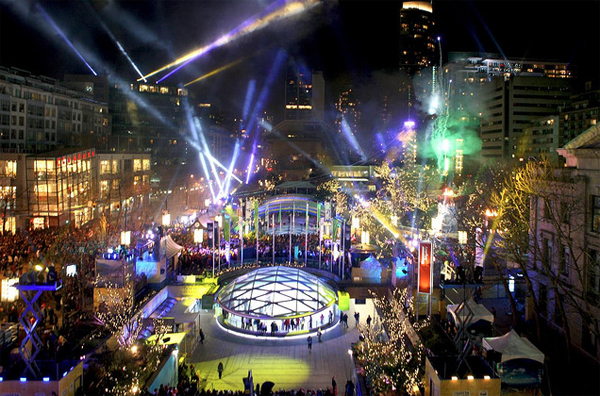It was 10 years ago today, July 2, 2003, when International Olympic Committee president Jacques Rogge was handed the envelope that concealed a card reading "Vancouver."
It wasn't apparent then, but the slim, three-vote decision to award the 2010 Winter Olympics to Vancouver instead of PyeongChang, South Korea, had wide-ranging impacts that changed the city and British Columbia forever; economically, politically and socially.
Some plans unfolded in orderly fashion. There were also many unintended consequences. Here, a look the Olympics' lasting effects on the city, and the province.
1. Creekside condo chaos
The original 1998 bid contemplated an Olympic Village at the University of B.C. endowment lands that would become student housing after the Games. The revised and final version for the IOC included a village at Southeast False Creek, across the inlet from B.C. Place Stadium. City hall's vision was to make the most luxurious and environmentally-friendly village in Olympic history. Wall Street hedge fund Fortress Credit Corporation was guaranteed that taxpayers would step in and finish the job if local developer Millennium faltered; which seemed a safe bet at the time. The real estate market was booming. Who thought the boom would go bust?
It did, in fall 2008. Vancouver city hall took over and the $1.1 billion complex was finished on time, but Millennium was petitioned into receivership in Nov. 2010. At the end of May 2013, 135 luxury condos were still for sale.
As many as two-thirds of the 1,100 units were originally earmarked for subsidized tenants, but the quota was set at 252 under NPA Mayor Sam Sullivan and halved to 126 under Vision Vancouver Mayor Gregor Robertson. (The other half was set aside for firefighters, nurses and teachers).
2. Downtown Eastside gentrification
The bid included a pioneering inner-city inclusivity statement to mollify fears that poverty-stricken Downtown Eastside residents would face eviction from landlords wanting to make a buck from Games labourers and visitors. Veteran newsman Dan Rather and United Nations housing envoy Miloon Kothari toured and reported on the squalor of the Downtown Eastside. Homes Not Games became the rallying cry of Anti-Poverty Committee protesters. Something had to be done and simply adding more more police to combat unrest, as mayor Sam Sullivan had attempted with the short-lived Project Civil City, wasn't going to cut it.
Fears of what would happen to the city's poorest were a big part of what sparked anti-Olympic protests beginning in May 2006. These marked the end of the honeymoon for VANOC (and Vancouverites didn't really embrace the Games until Canadian athletes began winning medals.)
The province's $37-million purchase of 10 Downtown Eastside hotels in 2007 did help save some of the single-room occupancy stock as the world turned away from Turin and toward Vancouver. Although, the improvements also attracted speculators whose investments have brought loft-style condos and gourmet eateries into a community still struggling with homelessness and addiction.
3. Fast-tracked road and rail
The bid promised better transport links between downtown and the airport and downtown and Whistler. Both happened.
Taxi drivers curse the Canada Line, because they lost business to the SkyTrain station inside the airport. Merchants along Cambie Street sold, moved or went out of business when the cut-and-cover tunnel construction drove customers away. On West Vancouver's Eagleridge Bluffs, the forest and swamp were bulldozed instead of tunneling through the mountainside.
It's smoother and marginally quicker to reach Whistler via the Sea-to-Sky Highway. Highway signs in English, Squamish and Lil'wat were erected on what was once a trading route. And, near the end of the so-called "Cultural Journey," a museum for the two tribes was built in Whistler.
4. Big budget venues
Vancouver's $87-million curling centre and Richmond's $187-million speedskating oval were transformed into community centres after the Games. Operating costs and admission fees rose in Vancouver to pay for the new complex. In Richmond, a $3-million infusion from taxpayers plus $2.5 million from the $110-million Games Operating Trust were needed to balance last year's budget of $11 million.
The University of British Columbia's $48-million Thunderbird Arena is hampered by a lack of rapid transit. Its biggest post-Olympic events were three Davis Cup international men's tennis match weekends in 2012 and 2013.
Whistler Sport Legacies operates the Whistler Olympic Park, Whistler Sliding Centre and Whistler Athletes' Centre. More than half of its $7.5-million budget last year was a taxpayer subsidy.
The $119-million Whistler Sliding Centre had a $2.2-million shortfall, despite revenue from tourist bobsled and skeleton rides. World cup and world championship sliding events draw a mere fraction of the throngs that came in February 2010. (A plaque in tribute to the late Nodar Kumaritashvili is nowhere near the site of the Georgian luger's fatal opening day crash on the track that was built faster than the architect ordered. VANOC executives feared it was dangerous almost a year earlier, but didn't add extra safety features until after the tragedy.)
The Callaghan Valley, earmarked in the 1980s for a nordic resort called Powder Mountain that was never built, became the nordic sports centre where women weren't allowed to ski jump for medals. The IOC and VANOC ignored an international campaign for equality. A Supreme Court of Canada challenge failed. The 2014 Games in Sochi, Russia, will have women's ski jumping.
5. Security-industrial complex
Security for the Olympics, which was North America's biggest peacetime air, land and sea military and police operation, cost taxpayers $900 million. That was substantially higher than the bid estimate of $175 million and included surveillance cameras, helicopters, frogmen, snipers, refueling jets and much more. You name it, Vancouver had it -- and most of it was not needed.
Masked protesters clashed with police and broke windows the morning after the Games opened. A concert barrier collapsed at the over-capacity David Lam Park live site, seriously injuring nine people. Crooks with stolen credit card numbers bought $2 million in tickets before VANOC noticed.
Meanwhile, several of the underworked, overstaffed police under RCMP command were fired from duty and returned to their home detachments for getting drunk and disorderly while off duty.
After the Games, Vancouver Police moved their headquarters to the vacated VANOC building in East Vancouver. In Richmond, the Vancouver 2010 Integrated Security Unit headquarters became the new home of the municipality's RCMP. The RCMP got a new 20-year provincial contract and built a $1-billion regional headquarters in Surrey (despite such embarrassments as the bungling the Robert Pickton mass-murder investigation and the wrongful Taser death of Robert Dziekanski in 2007.)
Bud Mercer, the veteran Mountie who commanded V2010 ISU, retired and went to work for Plenary Properties, the Australian company building new spy headquarters for the Communications Security Establishment Canada in Ottawa.
6. Industry got the gold
What started as an $3-billion upgrade to Highway 1 became an unprecedented $22-billion highway, bridge and rail expansion called the Pacific Gateway Program got underway in 2005, mainly for the benefit of Port Metro Vancouver. The Gateway project saw the replacement of the Port Mann Bridge with a tolled span, and expansion of new highways north and south of the Fraser to connect to terminals and increase trade with Asia.
7. HST
Those three dreaded letters. The credit crunch and recession meant Olympic sponsors like General Motors and Nortel needed bankruptcy protection. Others were forced to cut marketing budgets.
That meant fewer ads would be bought in the Olympic city and on TV, fewer bulk ticket buys, and fewer hotel room reservations for executives and their guests. It also meant VANOC needed more help from taxpayers.
Premier Gordon Campbell and finance minister Colin Hansen announced on July 23, 2009 that B.C. would have a value-added tax -- a harmonized sales tax -- the following year. The five per cent GST would merge with the seven per cent PST and expand to products not previously taxed.
Harmonization was an offer Campbell couldn't refuse, despite promising not to before he won re-election two months previous. The federal government put up $1.6 billion and the B.C. government would be better prepared if another sponsor went bankrupt or the IOC sued, which were among the worries outlined in an internal risk management report.
Campbell landed on his feet after being forced to resign by several caucus members in October 2010. He was appointed Canada's High Commissioner in London the summer of 2011. The HST was phased out in April after the August 2011 referendum.
8. Stanley Cup riot
Although Canada won Olympic hockey gold on the last day of the Games, Vancouverites didn't party like it was 1994 -- the year the Canucks' Stanley Cup loss in New York sparked a riot on Robson. Instead, a relatively calm and civil celebration ensued. Citing this precedent, Mayor Gregor Robertson ordered streets closed around the main post office and library for big screen viewing of Vancouver Canucks' 2011 Stanley Cup playoff games.
The Canucks lost Game 7 of the final at home to the Boston Bruins. The outnumbered, unprepared Vancouver police needed suburban reinforcements to deal with the angry, drunken mobs who set fires and broke windows. Two years later, 229 people had been charged and one convicted. Some cases are bound to continue beyond next February's Sochi Olympics.
9. Renewed roof
B.C. Place Stadium's future hinged upon the bid decision. If the IOC didn't choose Vancouver, the 1983-built stadium was facing potential demolition and replacement with condominiums. If it had not been scheduled to host the 2010 Games' opening and closing ceremonies, it would've been just another embarrassing event. Instead, the Jan. 5, 2007 rip and collapse of the inflated fabric roof went viral on YouTube and was carried by media around the world. Penny-pinching stadium management didn't want the roof-heating system turned on during a cold, snowy morning. They lost the gamble, but gained a new roof.
A year later, a $75-million like-for-like replacement plan evolved into a $253-million retractable concept, but engineers figured timelines were too tight to make it work before the Games. Renovations began anyway and the final cost was $514.2 million. It reopened Sept. 30, 2011.
10. BC Liberals hat-trick
Perhaps none has benefited more from the Olympics than the BC Liberal Party.
The bid was born under the premiership of the NDP's Glen Clark. When ex-Vancouver mayor Gordon Campbell led the BC Liberals to take all but two of the seats in 2001's election, he found himself not only holding the reigns of power, but also reaching for the Olympic rings.
Just two years into office, he was part of the delegation that presented to the IOC in Prague, despite an embarrassing drunk driving incident in Hawaii six months earlier. Campbell's job was to guarantee B.C. taxpayers would take care of any losses.
When the bid was won, suddenly Campbell had a roadmap for at least two more terms. He was to become the Olympic premier in a province that had six premiers before him in only a 10-year span.
To build and stage the Games, it cost more than $6 billion. When Campbell came to power, B.C.'s public debt was $33.6 billion. Under successor Christy Clark, it is $56.1 billion and rising. The Office of the Auditor General chose not to conduct a post-Games tally. ![]()
Read more: BC Politics
















Tyee Commenting Guidelines
Comments that violate guidelines risk being deleted, and violations may result in a temporary or permanent user ban. Maintain the spirit of good conversation to stay in the discussion.
*Please note The Tyee is not a forum for spreading misinformation about COVID-19, denying its existence or minimizing its risk to public health.
Do:
Do not: